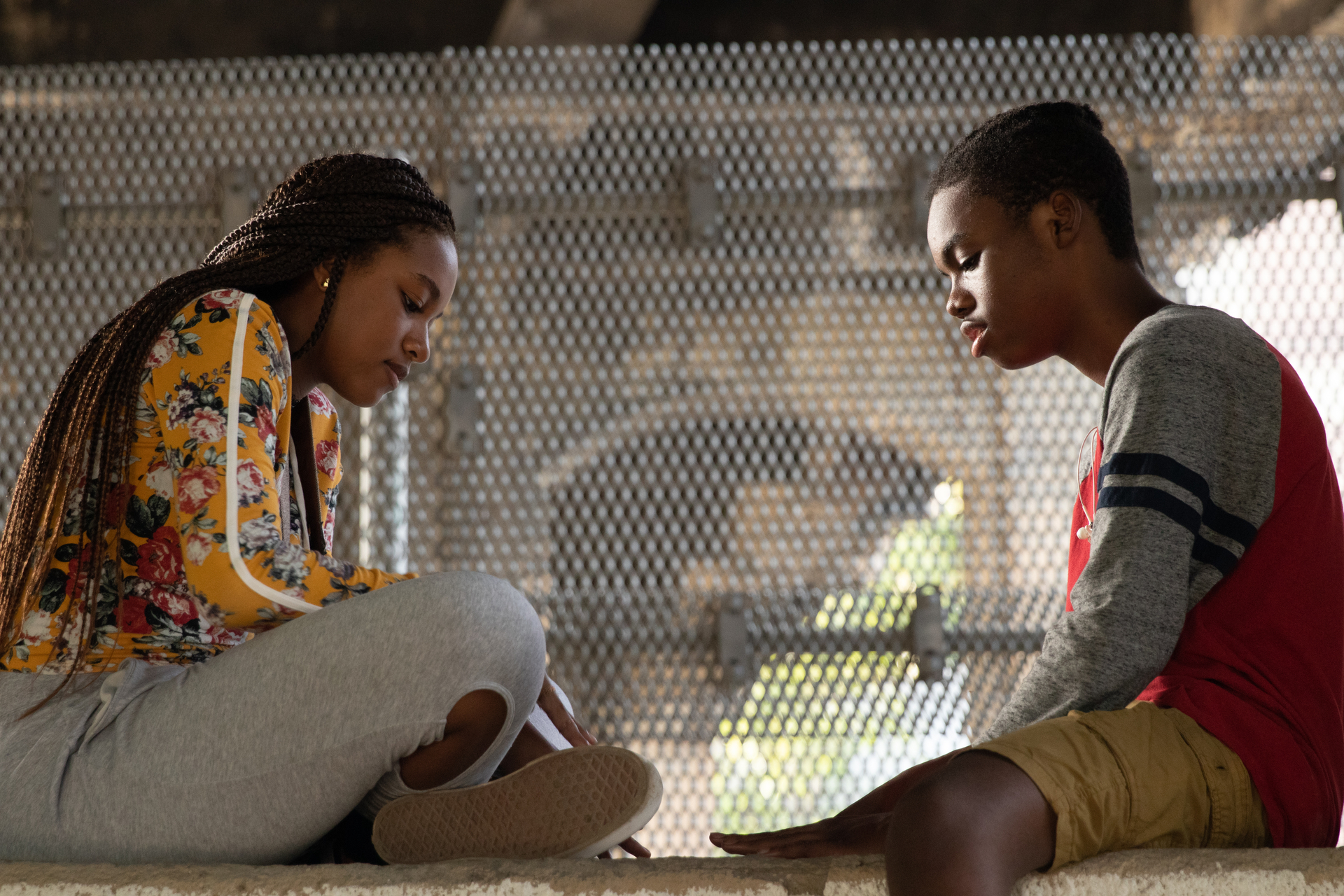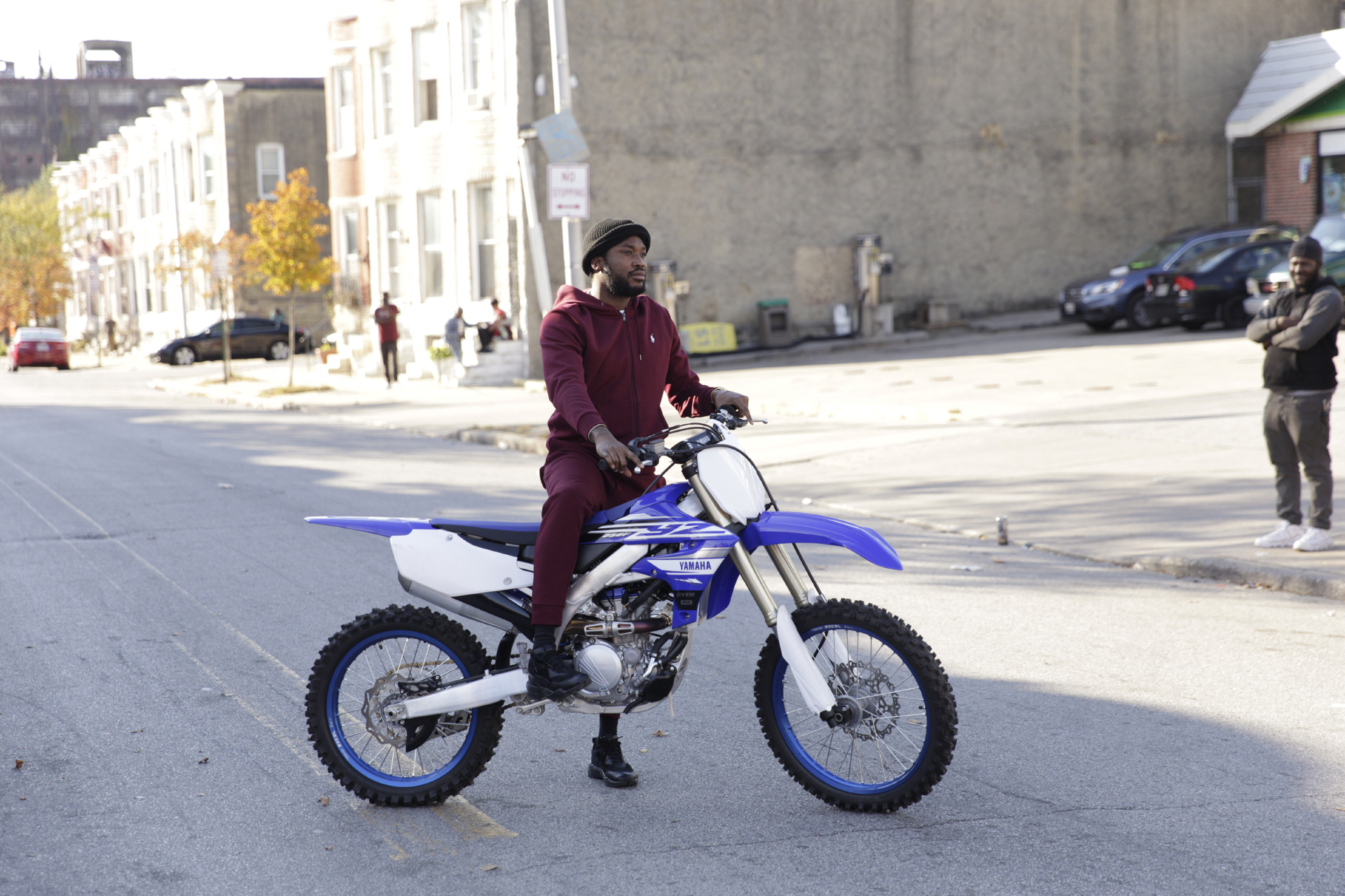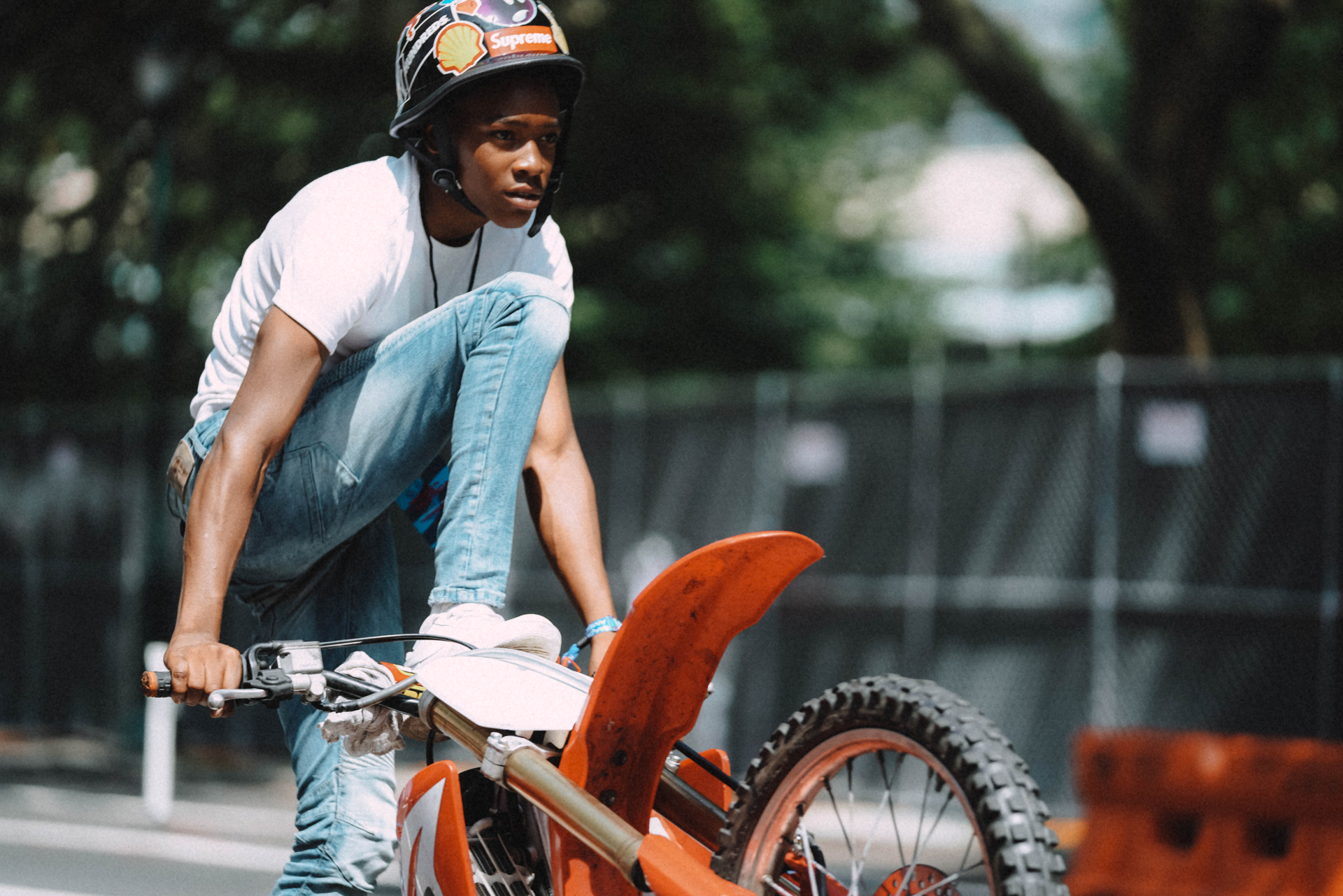The characteristics that distinguish a city often come from subcultures in underserved areas. HBO Max’s drama Charm City Kings highlights that in its portrayal of West Baltimore’s dirt-bike culture. The feature film adaptation of the 2013 Documentary 12 O’Clock Boys boasts an all-star behind the scenes team, including native Baltimore executive producers Caleb Pinkett and Jada Pinkett Smith as well as Barry Jenkins of Moonlight as one of the screenwriters.
The film’s director, Angel Manuel Soto, communicates effortless chemistry between onscreen newcomers, which include Meek Mill (Blax), and each delivers an electrifying and memorable performance.
The movie follows Mouse (Jahi Di’Allo Winston), an earnest 14-year old with a knack for rescuing animals. Mouse mourns the death of his older brother Stro, a legendary rider in the locally famed motorbike crew The Midnight Clique (MNC). As the film unfolds, Mouse’s dream of fulfilling his brother’s legacy and a coveted place in the MNC overpowers his childhood desire of becoming a veterinarian. The attempt to climb west Baltimore’s biker ranks strains Mouse’s relationships with his overworked mother, his two best friends—the comical Swear-Ta-Gawd (Kenzii Curtis) and impetuous Lamont (Donielle T. Hansley Jr. )—a budding love-interest and others. In rebelling against those who care for him, Mouse falls prey to drug dealing and plots a robbery to prove his “manhood.” He faces the consequences of his actions and the bleak odds of receiving a second chance.

While the premise of Mouse’s story isn’t especially novel, Charm City Kings shines because of its complex relationships, its look at masculinity and elegantly executed shots. We spoke with Angel Manuel Soto about his experience with filming in Baltimore, his take on why Mouse’s story is relatable to coming of age kids who may need a second chance and more.
This interview has been lightly edited and condensed for clarity purposes.
West Baltimore seems central to the storyline that’s represented in the movie, what was it like to film there and how did you go about reflecting its culture in the movie?
I really like to be embedded with the people and the culture and really absorb as much as I can so the camera captures that energy while I let them speak their truth to the audience.
When I went into Baltimore which was a city I’ve never visited before, it was a very familiar story to mine. In Puerto Rico, almost all of us growing up were either Mouse, Swear To God, or Lamont from the movie. I saw so much of my upbringing and saw so much of what happened to friends of mine in the script. I was like ‘this is a great story that I know I can tell authentically.’ It’s something that in every marginalized city, like, Baltimore and Puerto Rico more times than not, kids go through a similar experience. Being able to really capture the spirit of Baltimore and the community in Baltimore, I did my due diligence to go in there and spend time getting embedded with their way of life, going to see the bike rides, getting the community involved, getting involved in the culture so we could represent them as best as possible. By doing so organically the authenticity permeates through the city because you treat the city and the characters with the humanity that you expect in your home… Hopefully, in that way, it made it very inclusive for everyone to take ownership of the work we were doing.
I did my due diligence.
This film is inspired by the documentary 12 O’Clock Boys, and there were elements that carried over into this screenplay but it largely departs in that Charm City Kings is more of a drama. Did you feel like there were stylistic elements or perhaps a feeling and mood that you wanted to preserve or otherwise create for the film?
Visually, there was a reverence in the way the stunts and the rides were shot in the documentary that I really liked. I did a documentary about a boxer in Puerto Rico and boxing which tends to be a sport that is typically associated with hitting hard and knocking people out but in a deeper sense boxing is about not getting hit… it becomes a very technical and almost ballet-like coordination which becomes like a dance when your feet are strong rather than about just hitting hard, instead it’s about hitting strategically. With that, treating biking almost as a dance as opposed to a drag race brings out a sensibility that steals away from the toxic masculinity that can be present in either sport.
When it comes to portraying the way they feel about riding, the way they feel about hitting stunts and dancing on bikes while say, on a wheelie, that sense of freedom is something that they respect a lot. For them this is more than just getting a bike and riding fast it’s about balance, and it’s not necessarily about being ‘hard,’ it’s about being free.
Katelin Arizmendi’s [director of photography] work came into play respectively because she was able to show these stunts and show this world with a light and a lens that this [sport] is usually not depicted as.
This bike life in Baltimore is often or mostly seen as a criminal thing to do, it’s vilified and the community as a whole in bike culture has been criminalized and ostracized from society. What that does to the members of the community is systematic oppression in many ways because all they want to do is be able to ride free but the city prefers to spend money on police equipment than building them a place or designating a strip on one of those abandoned blocks for them to practice. So that’s when you start seeing that it’s a personal thing and it’s something that is close to their heart.

We see this full-circle moment in Mouse coming to terms with his relationships in his journey to attain a sense of status. How did you approach how you wanted to capture the different tensions and expressions of love in his friendships, love interest, family, and with his mentors?
Both Barry Jenkins’ first drafts and Sherman Paynes’ rewrites added a lot of heart to those moments. Sherman Payne did such a good job on focusing on the innocence of those kids. I was able to also pull from my own experiences and feelings to translate it on screen so that it felt very true. Coming together with kids who are actually the age they were portraying and not 18-year olds playing teenagers made their innocence and the authenticity of their innocence play out organically in the scenes that required that kind of childhood-like quality, especially when it comes to displaying the emotions of love, betrayal, and everything in between.
I also, personally, wanted the casting to have kids not necessarily playing ‘kids’ but kids pretending to be adults because that’s the arc of the movie. There’s a certain spark that gets lost when that innocence of being a kid disappears. I really need that type of spark to be represented in order to sell the very real and raw emotion that is required for portraying a teenager on screen.
Barry Jenkins’ first drafts and Sherman Paynes’ rewrites added a lot of heart.
Touching on the topic of mentors—one of the underlying themes of the film was Mouse coming to terms with his understanding of masculinity. How did the two opposite male mentors play into Mouse’s own recognition of formulating his sense of what masculinity is?
I don’t know if it was necessarily on purpose or not but when they were writing it I believe in spirit it was purposely done. There are some elements about the vulnerability of Black and Brown people in Barry Jenkins’ work and seeing Black and Brown men really tap into their emotions and owning their emotions. What I like about the development of the story as it went by is that subtextually a lot of the initial things still lingered throughout. For example, I felt like I didn’t have to say anything verbally to address or beat the concept of toxic masculinity over the head as being the reason why Mouse falls in trouble. His actions and the way he expresses himself such as saying things like ‘boys sit down, men go out and get it,’conveys that…
Black and Brown people aren’t a monolith and I think it’s worth trying to tell stories that are different. Particularly when talking about what we would want our futures to be [like].
The film also touches on several themes in regard to the justice system, policing and the lack of opportunity in certain communities. In your view, what’s the significance of having this narrative represented, particularly today?
We did have a conversation of what impact a film like this can have on what’s going on or the opposite, like how what’s going on impacts the film. What we wanted to do for Rivers is not [to] say that cops are a certain way but actually exemplify what a good cop looks like as opposed to not. It’s not us throwing in a towel to racism or brutality, no, all of that is f*cked up beyond belief and we will forever denounce that. If you see this movie and take anything from it, it’s that Rivers went out of his way to protect youth and encouraged them to fulfill his full potential. That’s what you have to do as an officer and you’ll see a difference in society rather than keeping people marginalized into poverty. Instead, start encouraging them, it doesn’t cost anything to show a little heart and love and care for the community. Most police in marginalized cities and police departments don’t even live in the counties communities they work in, so the engagement with the community isn’t like it used to be. I’ve seen news stories about how in other places that have practiced different types of involvement they’ve seen a difference when the police come in and as someone who actually exists to protect people and not to criminalize people and to offer that to not just rich people but to all people.

Did any aspects of directing the film La Granja and/or the experience of doing so translate into directing Charm City Kings?
100 percent. I approached this story as if I was doing La Granja. I went into it knowing I had to be resourceful and wanted to put a focus on the setting. La Granja ultimately is really about a city and the people that live there and Charm City Kings, even though it’s a story about Mouse and his friends, is as well. I always tackled location not as just a backdrop but [as] active characters that inform the backstory of the characters in the movie… how they are, how they live, and how they view life.
It’s [asking] ‘what can we do as members of society to change things’ and I think that’s the conversation that I hope people have.
What do you hope people will take away from watching this movie?
I hope people really focus on the fact that these kids, even though it’s a fiction movie that’s inspired by reality, I hope people feel as though we went far and beyond to create an entertaining experience that hits the right notes of a coming of age drama within a crime saga.
Again, I really want people to understand that there’s a Mouse everywhere in the world and that there’s a West Baltimore city in every major city in America and even the world. Puerto Rico is it’s own Baltimore in the middle of the ocean and this story is not an exception, this is the reality for millions of kids and there’s something each of us can do as a society to help kids like Mouse achieve their full potential when the government and institutionalized racism that exists works overtime to keep them from achieving it. It’s [asking] ‘what can we do as members of society to change things’ and I think that’s the conversation that I hope people have.







